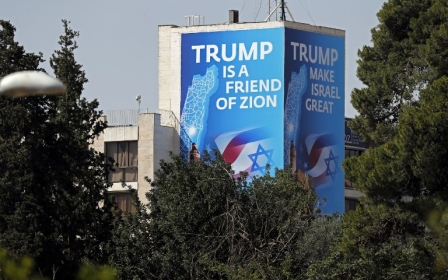Israel closes Gaza goods crossing after Friday protests

The only goods crossing between Gaza and Israel was closed until further notice on Saturday after it was damaged during a weekly protest by Palestinians.
Dozens of demonstrators broke into the Palestinian side of the Kerem Shalom terminal on Friday, setting a pipeline that delivers gas from Israel and a goods conveyor belt alight.
The incursion took place during the "Great March of Return" protest which Palestinians have organised every Friday for six-weeks on Gaza's border with Israel.
The Israeli side of the crossing, several hundred metres away, was not breached.
"The crossing will remain closed until the damage caused by the riots are repaired and will reopen in accordance with a situation assessment," the Israeli military said, adding that in the meantime it will be opened for humanitarian cases only.
It accused the protesters of being "under the auspices of Hamas," the group that runs the Gaza strip, without providing evidence.
It was unclear to some Gaza residents why the demonstrators chose to attack the terminal.
"I cannot find one good reason for what happened. What is the wisdom behind this?" said one gas station owner, who asked not to be identified.
"Some petrol stations have storage for maybe a day or two, so the crisis will begin by Monday or Tuesday should the crossing remained closed," he said.
The Palestinian National Committee said it was "surprised by the non-deliberate and unfortunate incident that damaged property" at Kerem Shalom and called on Palestinians to preserve the crossings.
On Saturday evening the Israeli military struck Gaza, Haaretz reported. According to Palestinian reports, the Israel Air Force fired seven missiles towards an agricultural area east of the city of Beit Hanoun. No casualties were reported. The army later said the strike targeted a tunnel.
'Foreboding Friday'
On Friday, thousand of Palestinians gathered along the Israel-Gaza frontier. Reports emerged that Israeli forces were heavily firing tear gas at the crowds in some areas, while one protester was killed and at least five protesters were shot with live bullets east of Gaza City.
On Saturday, the Gaza Ministry of Health said Jamal Abdel Rahman Afaneh, 15, died from wounds sustained during Friday's protest. His death brought to 54 the number of Palestinians killed since clashes began on 30 March, with hundreds of others injured.
Many have been shot and killed by Israeli snipers. Israel says it has acted to defend its border and has accused the protests of being directed by Hamas.
No Israelis have been injured.
The protesters have been calling for the right of return for Palestinian refugees forced from their homes in present-day Israel during the 1948 Arab-Israeli war.
Friday's demonstration was dubbed "Preparedness and Foreboding Friday," in anticipation of the final protest of the march early next week.
The march was initially set to end on 15 May, the 70th anniversary of the Palestinian Nakba (Catastrophe), in which more than 750,000 Palestinians were forcibly displaced by Israeli forces.
However, the final demonstration has been scheduled for Monday 14 May due to the imminent beginning of the Muslim holy month of Ramadan.
Kerem Shalom is the only crossing open to transport goods into and out of Gaza, including fuel and food. A separate people crossing in northern Gaza remains open.
Separately Egypt opened its border crossing with Gaza, the only one not with Israel, for four days Saturday.
Tens of thousands of Gazans are expected at tented border encampments in the coming days to protest against the opening of the US embassy in Jerusalem.
New MEE newsletter: Jerusalem Dispatch
Sign up to get the latest insights and analysis on Israel-Palestine, alongside Turkey Unpacked and other MEE newsletters
Middle East Eye delivers independent and unrivalled coverage and analysis of the Middle East, North Africa and beyond. To learn more about republishing this content and the associated fees, please fill out this form. More about MEE can be found here.




